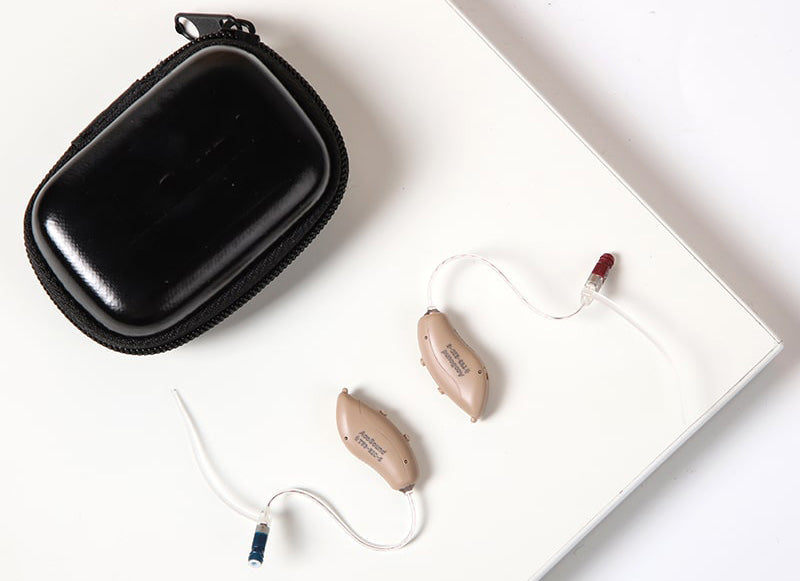Since RIC hearing aid also has part of the hearing aid sitting behind the ear, some would say RIC hearing aid is also considered a BTE hearing aid. To determine whether BTE or RIC hearing aid fits your needs, how to choose between BTE hearing aid and RIC hearing aid, there are multiple determining factors.
BTE Hearing Aid
BTE hearing aid is an abbreviation for Behind-the-Ear hearing aid, people alse call it Over-the-Ear hearing aid. Just like the image shown below as we can see the behind-the-ear hearing aid has a behind-the-ear part, and that’s the body of the hearing aid, with a tube feeding an earmold or a rubber dome-shaped earpiece into the ear.

On the body of the hearing aid there are microphones of the hearing aid, multi-functional buttons, and a battery component. Sounds from the environment would first get pick-up by the hearing aid microphones, then get processed and amplified through the processing chips that are located inside the body of the hearing aid. The amplified sounds will be sent into the ear through the hearing aid tubing.
RIC Hearing Aid
RIC hearing aid is an abbreviation for Receiver-In-the-Canal hearing aid. The Receiver is another name for Speaker, and just like the name indicated, the speaker of the RIC hearing aid will sit inside the individual’s ear. Like the BTE hearing aid, the body of a RIC hearing aid also sits behind the ear, and on the body of the hearing aid there are microphones for the hearing aid, multi-functional buttons, and a battery component.

On the other hand, differently from the BTE hearing aid, instead of a thick tubing connecting the body of the hearing aid to the earpiece that’s sitting inside the ear; For the RIC hearing aid, what connects the body of the hearing aid and the earpiece is a thin wire.
Regarding how sounds get processed, for the RIC hearing aid, sounds from the environment will also first get pick-up by the hearing aid microphones, and they will get processed through the chips locate inside the body of the hearing aid. However, the processed sounds will get sent down to the receiver or the speaker that’s sitting inside the ear to get amplified through the thin wire.
How to choose between BTE hearing aid and RIC hearing aid
Here are AcoSound suggestions on hot to choose your suitable hearing aid.
When should you choose BTE hearing aid?
- Most of the time is for people who have severe / profound hearing loss, where more powerful amplification is needed. When stronger amplification is needed, a bigger battery is also required, and the bigger the battery the most likely the bigger the hearing aid.
- People who have recurrent ear infections, ear drainage, or chronic middle ear issues. Moisture, drainage, and any electric components, such as a hearing aid speaker are not a good combination. So in between the BTE and RIC styles of hearing aids, BTE with an earpiece and tubing might be a better option when compared to the RIC style of hearing aid.
- Someone who has low vision and / or dexterity issues. BTE hearing aid tends to be bigger when compared to RIC hearing aid; therefore, it is easier to handle and see.
- Some people are just used to the BTE style of hearing aid, especially long-time hearing aid users.
When to choose RIC hearing aid
- Hearing loss is mainly in the high-pitched area, with a degree of hearing loss of mild to moderate.
- Cosmetic reasons. Compared to the BTE hearing aid, RIC hearing aid had a more delicate and discreet look, even though the body of the hearing aid sits outside the ear.
- More natural sound quality with less occlusion effects, or ear-plugging sensation.
- More comfortable fit.

